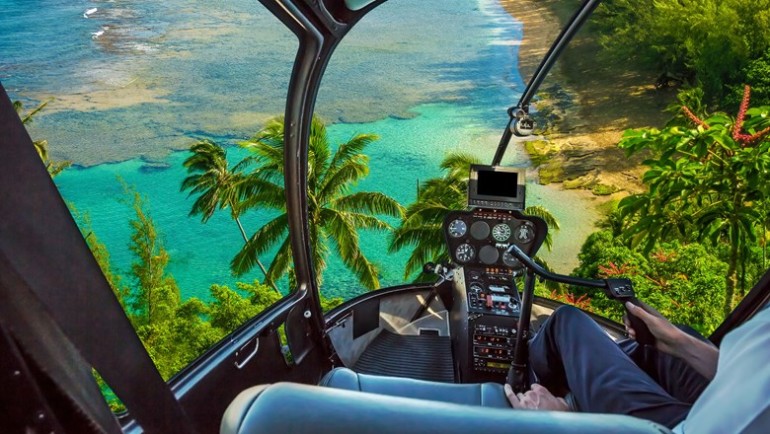Sponsored Listings:
Following a fatal crash on Kauai the day after Christmas, Hawaii’s helicopter and small-aircraft tour industry is facing renewed calls for stricter rules that could significantly alter operations, including a ban on flights over national parks.
As tourism has steadily grown in the Aloha State in the last decade, the number of air tours offering a glimpse of the Islands’ stunning scenery has also soared. Prior to 2019, when three air tour crashes resulted in 21 deaths, some Hawaii residents and politicians were already calling for regulations to limit noise pollution and other air traffic nuisances.
Then in August, following a Kailua helicopter crash that killed three last April and a skydiving plane crash on Oahu’s North Shore that killed 11 in June, Rep. Ed Case (D-Hawaii) introduced the Safe and Quiet Skies Act.
The legislation would, among other things, create a new decibel limit for flights over residential areas, ban flying over national parks, wilderness areas, cemeteries and military sites and forbid pilots from acting as tour narrators — measures industry representatives have said would be crippling.
Several factors, Case said, have led to an untenable situation in his view, including the rapid increase in the number of flights and demand for more unique experiences.
“I think a mindset has taken hold in the Hawaii helicopter tour industry where they think they can do whatever they want,” Case said. “They don’t owe any obligation of safety or community disruption avoidance to folks on the ground, and we should just take it. It’s the Wild West.”
A Hawaii DOT report shows 8,246 helicopter landings at Hawaii airports in March 2019, a 67% increase over March 2010. Last year, 19 of Oahu’s 33 neighborhood boards signed a letter calling for more regulations on air tours that “pose increased safety risks to our communities and have increasingly disrupted our neighborhoods and lives throughout Oahu.”
Hawaii Volcanoes National Park is the most popular place for flight tours in the entire National Park System, with 8,333 in 2018, while Maui’s Haleakala National Park has the fourth-most flights.
“Why did we create these parks in the first place?” Case asked. “The point is to commune with nature and preserve the environment. I think it destroys the ambience of the parks, and they should not be flown over.”
Case added that Pearl Harbor National Memorial managers have also voiced concerns about escalating air traffic.
On Jan. 15, a coalition of groups and agencies, including the Hawaii Helicopter Association (which did not respond to requests for comment), the Hawaii DOT Airports Division and the General Aviation Council of Hawaii, announced the formation of the Hawaii Air Tour Task Force to “address safety and noise issues related to rotor and fixed-wing aerial tours in the state of Hawaii.”
Safari Helicopters, the tour company operating the Kauai flight, said in a statement that it cannot comment on the crash as the investigation is still pending. The company also suggested that Case “better educate himself before proposing regulatory actions that are not based in factual information and that may produce negative effects to the local economy and its citizens.”
“The language of Congressman Case’s statements on [the Safe and Quiet Skies Act] constitute nothing more than the use of scare tactics,” the statement reads.
Travel advisors said there is a common consumer pattern after a helicopter crash. First, there is a surge of calls and cancellations.
But, said Oahu-based advisor Paula Takamori, “Eventually, things settle back to their normal booking patterns. We do not ever try to talk anyone into going on any tour of any sort. Clients must feel comfortable with the type of tour it is, and they know their own physical and mental limitations.”
Case also faulted the FAA for being slow to respond to concerns raised by the National Transportation Safety Board (NTSB), and his legislation would also allow local jurisdictions to pass their own flight regulations.
“Safety is the FAA’s top priority, and the FAA’s air tour regulations include safety requirements that are specific to Hawaii operations,” an agency spokesman said in a statement. “While we are always looking for possible trends, we have not identified current issues of concern that are applicable to the industry statewide.”
Out of 54 helicopter and small-aircraft accidents investigated by the NTSB in the previous five years, nine, or 17%, occurred in Hawaii.
Honolulu native and lawyer Roy Chang, who said he has handled at least a half-dozen helicopter fatality or injury cases in the past 15 years, is in favor of a review of regulations and increased monitoring.
“Accidents usually come down to one of two things: pilot error or some malfunctioning of the aircraft,” Chang said. “It shouldn’t just be when there is a crash, and then you forget about it. Every five years or so they should convene a group of experts and identify the problems. A lot of issues have to do with training for various conditions and equipment maintenance. Helicopter tours will never be 100% safe, but they can be safer.”
The NTSB’s preliminary report for the Kauai crash does not reveal the cause but did cite a witness who said visibility was roughly 20 feet, with rain and fog. Chang said it was of particular concern that the pilot was not instrument certified, according to the report, which is not required by regulations.
“I think having pilots who are not instrument-rated is a big mistake,” Chang said. “When you get to Hawaii, weather systems can come on you very quickly, and if you can’t fly by instrument that puts everyone at risk.”
Source: travelweekly.com










